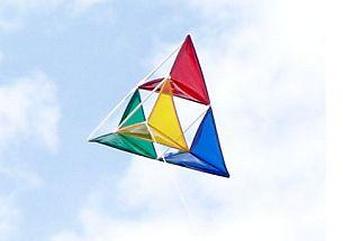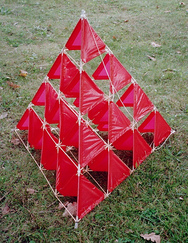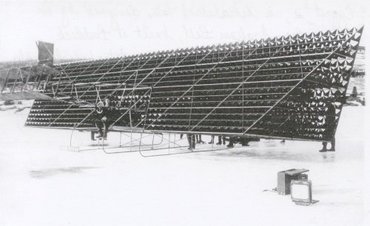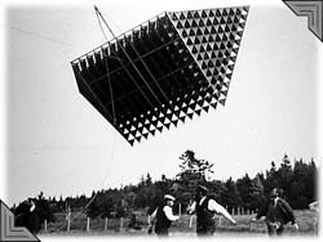Tetrahedral Kite
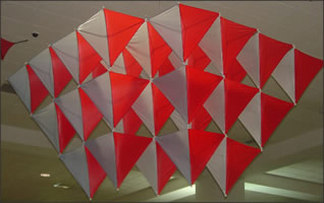
A tetrahedral kite is a multicelled rigid box kite composed of tetrahedrally shaped cells. The cells are usually arranged in such a way that the entire kite is also a regular tetrahedron. The kite can be described as a compound dihedral kite as well.
This kite was invented by Alexander Graham Bell. It came about from his experiments with Hargrave's Box Kites and his attempts to build a kite that was scalable and big enough to carry both a man and a motor. As such, it was an early experiment on the road to manned flight. He worked on the kites between 1895 and 1910. Bell wrote about his discovery of this concept in the June 1903 issue of National Geographic magazine; the article was titled "Tetrahedral Principle in Kite Structure".
From an initial one cell model, Bell advanced to a 3,393 cell "Cygnet" model in 1907. This 40-foot (12.2 m) long, 200 pound (91 kilogram) kite was towed by a steamer offshore near Baddeck, Nova Scotia on 6 December 1907 and carried a man 168 feet (51.2 metres) above the water.
Bell also experimented with a large circular "tetrahedral truss" design during the same period.
The tetrahedral kite, while not easy to make compared to the simple cross kite, is very stable and easy to fly. It flies well in moderate to heavy winds if it is properly set up.
This kite was invented by Alexander Graham Bell. It came about from his experiments with Hargrave's Box Kites and his attempts to build a kite that was scalable and big enough to carry both a man and a motor. As such, it was an early experiment on the road to manned flight. He worked on the kites between 1895 and 1910. Bell wrote about his discovery of this concept in the June 1903 issue of National Geographic magazine; the article was titled "Tetrahedral Principle in Kite Structure".
From an initial one cell model, Bell advanced to a 3,393 cell "Cygnet" model in 1907. This 40-foot (12.2 m) long, 200 pound (91 kilogram) kite was towed by a steamer offshore near Baddeck, Nova Scotia on 6 December 1907 and carried a man 168 feet (51.2 metres) above the water.
Bell also experimented with a large circular "tetrahedral truss" design during the same period.
The tetrahedral kite, while not easy to make compared to the simple cross kite, is very stable and easy to fly. It flies well in moderate to heavy winds if it is properly set up.
Alexander Graham Bell
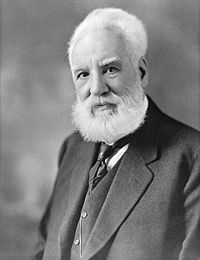
In 1891, Bell had begun experiments to develop motor-powered heavier-than-air aircraft. The AEA (Aerial Experiment Association) was first formed as Bell shared the vision to fly with his wife, who advised him to seek "young" help as Alexander was at the graceful age of 60.
In 1898, Bell experimented with tetrahedralbox kites and wings constructed of multiple compound tetrahedral kites covered in silk. The tetrahedral wings were named Cygnet I, II and III, and were flown both unmanned and manned in the period from 1907–1912.
The AEA's work progressed to heavier-than-air machines, applying their knowledge of kites to gliders. Moving to Hammondsport, the group then designed and built the Red Wing, framed in bamboo and covered in red silk and powered by a small air-cooled engine. On March 12, 1908, over Keuka Lake, the biplane lifted off on the first public flight in North America. The innovations that were incorporated into this design included a cockpit enclosure and tail rudder (later variations on the original design would add ailerons as a means of control). One of the AEA's inventions, the aileron, which was also created independently by Robert Esnault-Pelterie and several others, was to become a standard component on all airplanes. The White Wing and June Bug were to follow and by the end of 1908, over 150 flights without mishap had been accomplished. However, the AEA had depleted its initial reserves and only a $15,000 grant from Mrs. Bell allowed it to continue with experiments.
Bell's pioneering work with the tetrahedral form led to a number of applications. The use of the tetrahedral in the structure of large kites, some of them big enough to carry a person aloft, was remarkable. His experimentation with the tetrahedron was used in construction projects (a tower on his property at Beinn Breagh in Cape Breton, N.S. and other structures) as well as in kite framing. Some of the sketches in his notebooks of tetrahedral design ideas show how enamored he was with the utility and strength of the tetrahedron as a three dimensional structure.
In 1898, Bell experimented with tetrahedralbox kites and wings constructed of multiple compound tetrahedral kites covered in silk. The tetrahedral wings were named Cygnet I, II and III, and were flown both unmanned and manned in the period from 1907–1912.
The AEA's work progressed to heavier-than-air machines, applying their knowledge of kites to gliders. Moving to Hammondsport, the group then designed and built the Red Wing, framed in bamboo and covered in red silk and powered by a small air-cooled engine. On March 12, 1908, over Keuka Lake, the biplane lifted off on the first public flight in North America. The innovations that were incorporated into this design included a cockpit enclosure and tail rudder (later variations on the original design would add ailerons as a means of control). One of the AEA's inventions, the aileron, which was also created independently by Robert Esnault-Pelterie and several others, was to become a standard component on all airplanes. The White Wing and June Bug were to follow and by the end of 1908, over 150 flights without mishap had been accomplished. However, the AEA had depleted its initial reserves and only a $15,000 grant from Mrs. Bell allowed it to continue with experiments.
Bell's pioneering work with the tetrahedral form led to a number of applications. The use of the tetrahedral in the structure of large kites, some of them big enough to carry a person aloft, was remarkable. His experimentation with the tetrahedron was used in construction projects (a tower on his property at Beinn Breagh in Cape Breton, N.S. and other structures) as well as in kite framing. Some of the sketches in his notebooks of tetrahedral design ideas show how enamored he was with the utility and strength of the tetrahedron as a three dimensional structure.
